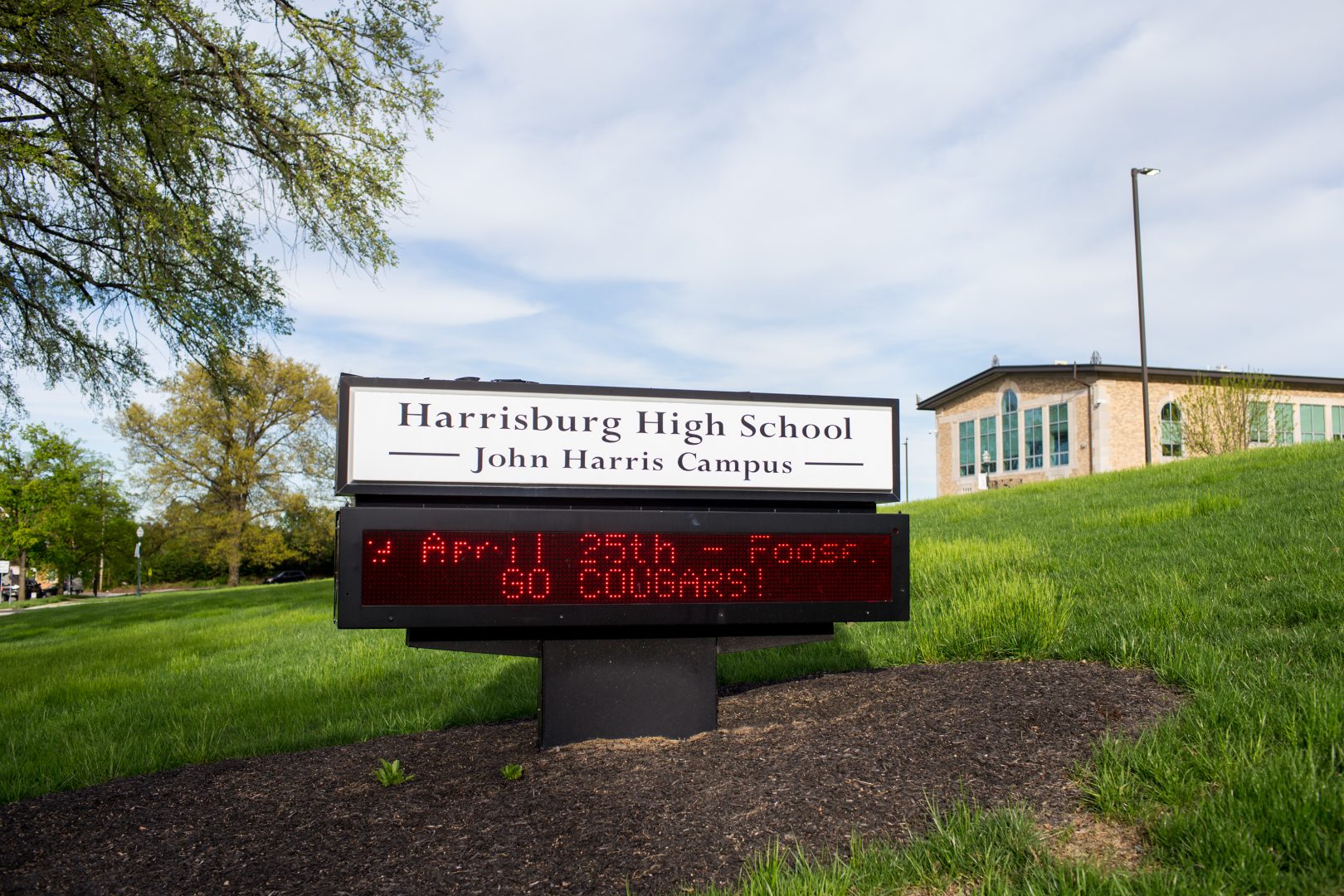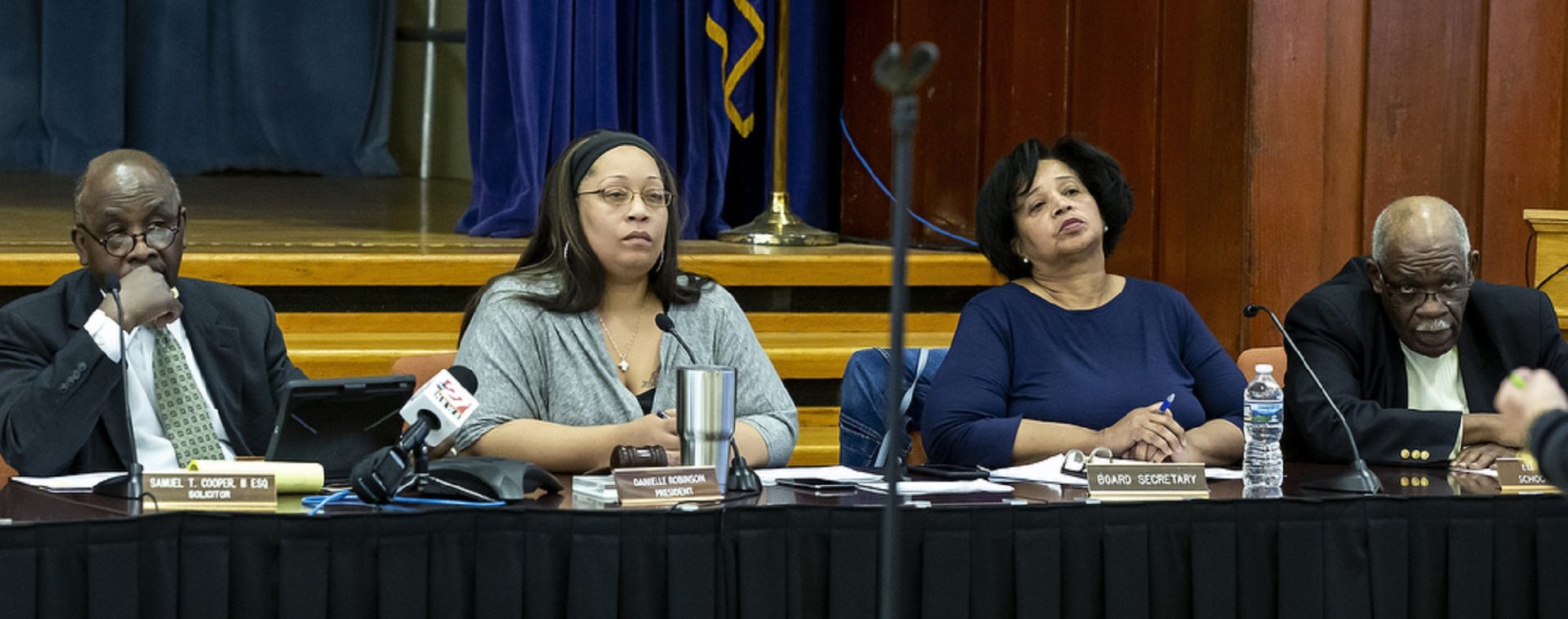
Harrisburg High School is seen in this April 24, 2019 photo.
Sean Simmers / PennLive

Harrisburg High School is seen in this April 24, 2019 photo.
Sean Simmers / PennLive

Sean Simmers / PennLive
Harrisburg High School is seen in this April 24, 2019 photo.
(Harrisburg) — Calls for the state to take over the troubled Harrisburg School District grew louder last week as tensions continue to mount among local leaders over fiscal management concerns, questionable hirings, high teacher turnover, and persistently poor test scores.
Harrisburg Mayor Eric Papenfuse is calling for the state to step in and put the district into receivership — essentially giving a state-appointed receiver control of district operations. Republican Sen. John DiSanto and Democratic Rep. Patty Kim, both of whom represent the city, support that move. And at least one elected school board member, Ellis Roy Jr., is saying it’s time to surrender local control over the school system.
State takeovers of school districts have been occurring for more than three decades in this country with mixed results. Leaving a community voiceless in the running of its schools is not a matter to be taken lightly, and takeovers tend to last longer than most local folks would like. But those who advocate this last resort option hope it will kickstart a turnaround, starting in the district’s central office.
With much of the recent news from the school district focusing on the school board’s refusal last week to cooperate with state auditors — a position district officials reversed late Friday — as well as divisions among board members and even a call by some board members for a vote to oust the superintendent, Kirk Hallett believes placing the district in state receivership is the only choice.
Hallett, director of the nonprofit Joshua Group which works with at-risk Harrisburg youth at the Joshua Learning Center in Allison Hill, calls the district “a total chaotic mess.”
He sees firsthand how district students are being educationally short-changed. High schoolers come into his center for homework help who can’t read past grade school levels. Yet, he said, they get passed on from one grade to the next or are allowed to graduate.
Hallett is also on the board of an organization seeking to establish a charter school, the Pennsylvania STEAM Academy. The school board has rejected its charter application, and it is appealing.
While he would love to see the district fix itself, Hallett said too few people in the community are coming forward to demand change. He reluctantly agrees with Papenfuse that even if voters elect new board members this year, it’s too little, too late.
It’s time for the state to step in, he said.
“It’s a sad ending to a bad story but it’s the only reasonable chance the 7,000 kids have of somebody coming in and getting that ship running right,” Hallett said.

Vicki Vellios Briner / PennLive
The Harrisburg School District Board held a special meeting to vote on hiring in-house solicitor James Ellison, Monday, April 22, 2019.
Calls in Pennsylvania and beyond for state takeovers of a dysfunctional districts sound all too familiar to educational experts, who talked about the pros and cons of such an action.
“The pros are clearly that the relationship between the state and that particular local agency become much better,” said Gerald Zahorchak, a former state education secretary who now serves as an associate professor of education at University of Pittsburgh Johnstown.
“It provides sort of an opportunity for improving internal control systems so they will line up with what are the expectations of the state with regard to just about everything across a large continuum of control needed inside districts for overall management improvements to occur.”
Employees pay stricter attention to what the state-appointed officials want, he said. Compliance with state regulations is more closely adhered to. And the central administration and support services improve. Zahorchak said all that can happen within as little as a year or so.
Jay Himes, executive director of the Pennsylvania Association of School Business Officials, was more pessimistic in his view of state takeovers of districts.
“Experience has demonstrated that many of the challenges facing distressed school districts continue to exist regardless of who is in control,” he said.
Among those challenges: Classroom instruction and student performance show little improvement, morale remains low, high employee turnover continues, and the school environment as a whole doesn’t change without more resources to address the underlying socioeconomic issues of a community.
“One of the characteristics of most of these districts in financial and academic distress is they suffer terribly from an ineffective statewide school funding system. They don’t have the resources to meet the needs of kids in these districts where there tends to be a high concentration of poverty and kids with special needs,” said Ron Cowell, a former state lawmaker who is now president of the Harrisburg-based Education Policy and Leadership Center.
In Harrisburg, the total per-pupil expenditure approaches $20,000 and the instructional per-student spending is about $11,500, according to state education department data. For comparison, in Cumberland Valley School District, which has more than 2,000 more students, the total per-pupil spending is $14,300 and instructional per-student spending is about $7,500.
While urban districts tend to spend much more than their neighboring district across the river or even next door, Cowell said they still “don’t have the sufficient resources to meet the needs of kids in these districts.”

Vicki Vellios Briner / PennLive
The Harrisburg School District Board held a special meeting to vote on hiring in-house solicitor James Ellison, Monday, April 22, 2019.
In 2016-17, the state put in place a new statewide funding formula that factors in the needs of poor students and English language learners and directs more money to districts to educate those students. But that formula only applies to the new dollars added to the basic education funding line in the state budget since that formula’s adoption and not all $6 billion-plus earmarked in the budget for basic education.
Zahorchak said that needs to change. The formula needs to be applied to more than just any newly-appropriated money to make a difference in districts like Harrisburg. But it has to be done in a way that it doesn’t end up hurting districts or having unintended consequences, he said.
To do that requires a large injection of money, which is where some lawmakers’ efforts to apply the formula more broadly have hit a roadblock.
History has also shown that state takeovers last longer than most local residents want.
Philadelphia School District was taken over by the state in 2001 and didn’t have control returned to a newly elected school board until last July. Chester Upland School District in Delaware County has operated under three state-appointed receivers since 2012.
“They often last longer than they need to be,” said Rand Quinn, an associate professor of education at the University of Pennsylvania. “It’s hard to go back to local control.”
He came to Penn in 2012 and recalls hearing local advocates, parent organizations and teachers group at that time calling for returning Philadelphia School District to local control. Similar rumblings have been heard from the Chester Upland community.
Striking the right balance between not wanting to turn over the reins too soon or too late is important, Quinn said.
“This has to do with the history of schools in the United States. They’ve always been local institutions,” he said. “There’s a certain sense that schools are owned by the local communities, so to speak, and that this is an institution that should be determined and controlled by local communities.”
That’s why parents and teachers often want local control returned even if schools aren’t meeting expectations, Quinn said.
In Harrisburg’s case, the school district was placed under mayoral control in 2001 for nearly a decade. In 2012, the state declared the district in severe financial recovery, a status that led to a chief recovery officer being appointed and access to an interest-free loans. The district remains in recovery to this day.
Given that history and the division and dysfunction that has surfaced there in recent weeks and months, Quinn suggested it’s logical to consider the next consequence.
“It make sense to me that the receivership option is on the table,” he said.
Hallett said the local community has had its chance and the end result has been infighting, politicking, and turmoil that has proven to be a big distraction from the district’s main focus: educating the city’s youth.
“You need somebody to go in there and say this is the way we are going to do it,” he said. “You can keep your job but you better do this. I’m sorry but the local folks have not taken care of it – or they have taken care of it and let it continue. So for the sake of the 7,000 kids who are suffering at the end of the day, something has to happen. Something dramatic and unfortunately, the only dramatic thing that can happen is receivership, state takeover.”
PennLive and The Patriot-News are partners with PA Post.

Get insights into WITF’s newsroom and an invitation to join in the pursuit of trustworthy journalism.
The days of journalism’s one-way street of simply producing stories for the public have long been over. Now, it’s time to find better ways to interact with you and ensure we meet your high standards of what a credible media organization should be.